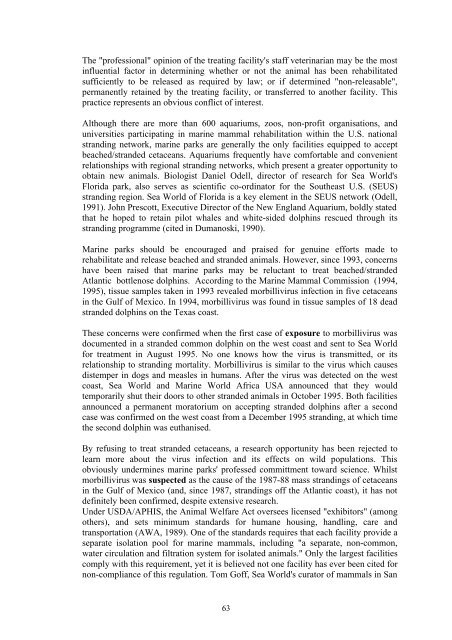Captive Cetaceans: A Handbook for Campaigners - Whale and ...
Captive Cetaceans: A Handbook for Campaigners - Whale and ...
Captive Cetaceans: A Handbook for Campaigners - Whale and ...
Create successful ePaper yourself
Turn your PDF publications into a flip-book with our unique Google optimized e-Paper software.
The "professional" opinion of the treating facility's staff veterinarian may be the most<br />
influential factor in determining whether or not the animal has been rehabilitated<br />
sufficiently to be released as required by law; or if determined "non-releasable",<br />
permanently retained by the treating facility, or transferred to another facility. This<br />
practice represents an obvious conflict of interest.<br />
Although there are more than 600 aquariums, zoos, non-profit organisations, <strong>and</strong><br />
universities participating in marine mammal rehabilitation within the U.S. national<br />
str<strong>and</strong>ing network, marine parks are generally the only facilities equipped to accept<br />
beached/str<strong>and</strong>ed cetaceans. Aquariums frequently have com<strong>for</strong>table <strong>and</strong> convenient<br />
relationships with regional str<strong>and</strong>ing networks, which present a greater opportunity to<br />
obtain new animals. Biologist Daniel Odell, director of research <strong>for</strong> Sea World's<br />
Florida park, also serves as scientific co-ordinator <strong>for</strong> the Southeast U.S. (SEUS)<br />
str<strong>and</strong>ing region. Sea World of Florida is a key element in the SEUS network (Odell,<br />
1991). John Prescott, Executive Director of the New Engl<strong>and</strong> Aquarium, boldly stated<br />
that he hoped to retain pilot whales <strong>and</strong> white-sided dolphins rescued through its<br />
str<strong>and</strong>ing programme (cited in Dumanoski, 1990).<br />
Marine parks should be encouraged <strong>and</strong> praised <strong>for</strong> genuine ef<strong>for</strong>ts made to<br />
rehabilitate <strong>and</strong> release beached <strong>and</strong> str<strong>and</strong>ed animals. However, since 1993, concerns<br />
have been raised that marine parks may be reluctant to treat beached/str<strong>and</strong>ed<br />
Atlantic bottlenose dolphins. According to the Marine Mammal Commission (1994,<br />
1995), tissue samples taken in 1993 revealed morbillivirus infection in five cetaceans<br />
in the Gulf of Mexico. In 1994, morbillivirus was found in tissue samples of 18 dead<br />
str<strong>and</strong>ed dolphins on the Texas coast.<br />
These concerns were confirmed when the first case of exposure to morbillivirus was<br />
documented in a str<strong>and</strong>ed common dolphin on the west coast <strong>and</strong> sent to Sea World<br />
<strong>for</strong> treatment in August 1995. No one knows how the virus is transmitted, or its<br />
relationship to str<strong>and</strong>ing mortality. Morbillivirus is similar to the virus which causes<br />
distemper in dogs <strong>and</strong> measles in humans. After the virus was detected on the west<br />
coast, Sea World <strong>and</strong> Marine World Africa USA announced that they would<br />
temporarily shut their doors to other str<strong>and</strong>ed animals in October 1995. Both facilities<br />
announced a permanent moratorium on accepting str<strong>and</strong>ed dolphins after a second<br />
case was confirmed on the west coast from a December 1995 str<strong>and</strong>ing, at which time<br />
the second dolphin was euthanised.<br />
By refusing to treat str<strong>and</strong>ed cetaceans, a research opportunity has been rejected to<br />
learn more about the virus infection <strong>and</strong> its effects on wild populations. This<br />
obviously undermines marine parks' professed committment toward science. Whilst<br />
morbillivirus was suspected as the cause of the 1987-88 mass str<strong>and</strong>ings of cetaceans<br />
in the Gulf of Mexico (<strong>and</strong>, since 1987, str<strong>and</strong>ings off the Atlantic coast), it has not<br />
definitely been confirmed, despite extensive research.<br />
Under USDA/APHIS, the Animal Welfare Act oversees licensed "exhibitors" (among<br />
others), <strong>and</strong> sets minimum st<strong>and</strong>ards <strong>for</strong> humane housing, h<strong>and</strong>ling, care <strong>and</strong><br />
transportation (AWA, 1989). One of the st<strong>and</strong>ards requires that each facility provide a<br />
separate isolation pool <strong>for</strong> marine mammals, including "a separate, non-common,<br />
water circulation <strong>and</strong> filtration system <strong>for</strong> isolated animals." Only the largest facilities<br />
comply with this requirement, yet it is believed not one facility has ever been cited <strong>for</strong><br />
non-compliance of this regulation. Tom Goff, Sea World's curator of mammals in San<br />
63

















